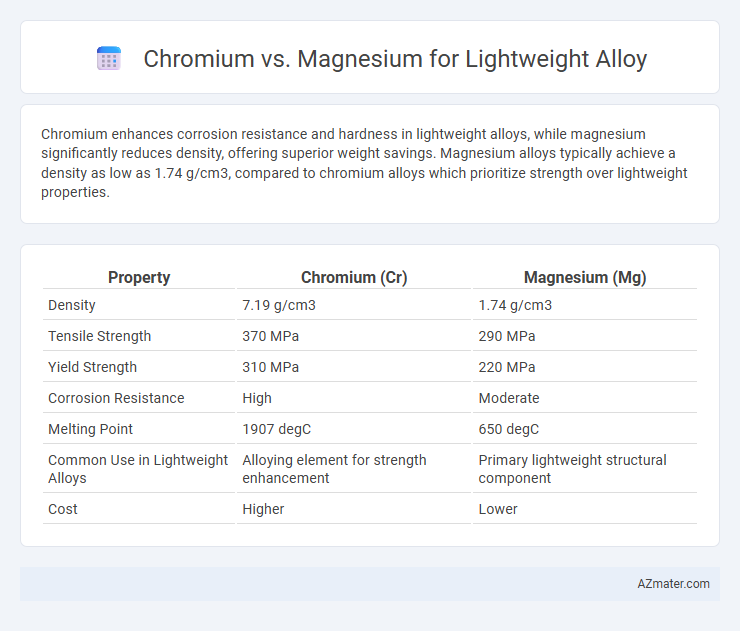Chromium enhances corrosion resistance and hardness in lightweight alloys, while magnesium significantly reduces density, offering superior weight savings. Magnesium alloys typically achieve a density as low as 1.74 g/cm3, compared to chromium alloys which prioritize strength over lightweight properties.
Table of Comparison
| Property | Chromium (Cr) | Magnesium (Mg) |
|---|---|---|
| Density | 7.19 g/cm3 | 1.74 g/cm3 |
| Tensile Strength | 370 MPa | 290 MPa |
| Yield Strength | 310 MPa | 220 MPa |
| Corrosion Resistance | High | Moderate |
| Melting Point | 1907 degC | 650 degC |
| Common Use in Lightweight Alloys | Alloying element for strength enhancement | Primary lightweight structural component |
| Cost | Higher | Lower |
Overview of Chromium and Magnesium Alloys
Chromium alloys offer exceptional corrosion resistance and high tensile strength, making them ideal for applications requiring durability and wear resistance. Magnesium alloys are prized for their ultra-lightweight properties and excellent strength-to-weight ratio, commonly used in aerospace and automotive industries to reduce overall mass. Both materials contribute unique benefits to lightweight alloy design, with chromium enhancing hardness and magnesium providing significant weight savings.
Chemical Properties Relevant to Lightweight Alloys
Chromium enhances corrosion resistance and hardness in lightweight alloys through its stable oxide layer, contributing to improved durability. Magnesium, characterized by its low density and high strength-to-weight ratio, significantly reduces overall alloy weight while maintaining structural integrity. The distinct chemical reactivity of magnesium necessitates protective measures against oxidation, whereas chromium's chemical stability aids in forming robust protective coatings in alloy formulations.
Density and Weight Comparison
Chromium has a density of approximately 7.19 g/cm3, significantly higher than magnesium's density of about 1.74 g/cm3, making magnesium substantially lighter for lightweight alloy applications. Magnesium alloys deliver superior weight reduction, ideal for aerospace and automotive industries seeking enhanced fuel efficiency and performance. Although chromium enhances strength and corrosion resistance when alloyed, its heavier mass limits its use where minimal weight is critical.
Strength and Structural Performance
Chromium enhances the strength and corrosion resistance of lightweight alloys by forming stable carbides and solid solution strengthening, which improves structural performance under high stress. Magnesium alloys, known for their low density, offer excellent strength-to-weight ratios but require alloying elements like aluminum and zinc to achieve comparable strength levels to chromium-enhanced materials. The combination of chromium in alloys provides superior hardness and fatigue resistance, making it ideal for applications demanding high structural integrity and durability.
Corrosion Resistance in Alloys
Chromium significantly enhances corrosion resistance in lightweight alloys by forming a stable, passive oxide layer that protects the metal from oxidation and environmental degradation. Magnesium alloys, while prized for their low density and strength-to-weight ratio, are inherently more prone to corrosion without adequate alloying elements or protective coatings. Incorporating chromium into magnesium-based alloys improves their durability and lifespan, making them more suitable for aerospace and automotive applications where both lightweight and corrosion resistance are critical.
Manufacturing and Processing Methods
Chromium enhances corrosion resistance and hardness in lightweight alloys but can complicate manufacturing due to its high melting point and tendency to form brittle intermetallics during processing. Magnesium alloys, favored for their low density and excellent machinability, require specialized casting and extrusion techniques to control oxidation and improve ductility. Advanced processing methods like powder metallurgy and thermal treatments help optimize the microstructure and mechanical properties of both chromium- and magnesium-based lightweight alloys for aerospace and automotive applications.
Cost and Economic Considerations
Chromium as an alloying element generally increases the cost of lightweight alloys due to its higher market price compared to magnesium, impacting overall material expenses. Magnesium alloys offer significant economic advantages in weight reduction, leading to fuel savings and lower emissions in automotive and aerospace sectors. However, the cost-effectiveness of magnesium depends on factors like corrosion resistance treatments and manufacturing complexity, which can affect the total lifecycle cost.
Environmental Impact and Sustainability
Chromium and magnesium differ significantly in their environmental impact and sustainability when used in lightweight alloys. Magnesium offers a lower carbon footprint due to its abundant availability and energy-efficient recycling processes compared to chromium, which often involves energy-intensive extraction and toxic byproducts. Sustainable alloy design increasingly favors magnesium for reducing greenhouse gas emissions and promoting circular economy practices in automotive and aerospace industries.
Application Suitability: Automotive, Aerospace, and Electronics
Chromium enhances corrosion resistance and hardness in lightweight alloys, making it ideal for aerospace applications requiring durability under extreme conditions. Magnesium's low density significantly reduces weight, benefiting automotive components aimed at fuel efficiency and performance. In electronics, the balance of chromium's strength and magnesium's lightweight properties supports the production of compact, resilient devices.
Future Trends in Lightweight Alloy Development
Chromium and magnesium play pivotal roles in advancing lightweight alloy technologies, with magnesium alloys gaining prominence due to their exceptional strength-to-weight ratio and recyclability, ideal for aerospace and automotive industries. Emerging trends highlight the integration of chromium as a microalloying element to enhance corrosion resistance and mechanical properties in magnesium-based alloys, driving innovation in high-performance materials. Research focuses on optimizing chromium-magnesium composites through powder metallurgy and surface treatments to meet future demands for sustainable, lightweight solutions in transportation and structural applications.

Infographic: Chromium vs Magnesium for Lightweight Alloy
 azmater.com
azmater.com